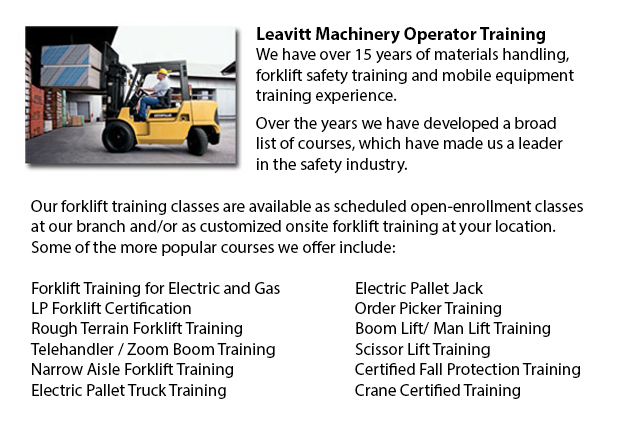
Forklift Training Schools Kelowna - Forklift Training Schools
Are you looking for work as a forklift driver? Our regulatory-compliant mobile equipment operator training provides instruction in types of lift trucks, pre-shift check, fuel types and handling of fuels, and safe use of a lift truck. Hands-on, practical training assists participants in acquiring basic operational skills. Course content includes current rules governing the use of lift trucks. Our proven forklift courses are designed to offer training on these kinds of trucks: narrow isle forklift, counterbalanced forklift and powered pallet truck.
Do not raise or lower the fork whilst the lift truck is traveling. A load must not extend higher than the backrest because of the danger of the load sliding back toward the operator. Check for overhead obstructions and make certain there is plenty of clearance before lifting a load. Stay away from overhead power lines. Once the load is lifted straight up, tilt it back slightly.
When the load is lifted the forklift will be less steady. Make certain that no pedestrians cross underneath the elevated fork. The operator should not leave the lift truck when the load is lifted.
When handling pallets, forks must be level and high enough to go into the pallet and extend all the way beneath the load. The fork's width should provide equal weight distribution.
Before loading or unloading the truck, set the brakes and chock the wheels. Floors have to be strong enough to support the weight of the load and the forklift combined. Fixed jacks can be installed to support a semi-trailer which is not attached to a tractor. The height of the entrance door should clear the forklift height by at least 5 cm. Mark edges of rail cars, ramps or docks and avoid them.
-
Counterbalance Forklift License Kelowna
Counterbalance Forklift License Kelowna - Forklifts, when operated by completely trained workers, are a major advantage to companies. We offer a thorough training program consisting of all parts of operating a powered lift device. Counterbalance fork... More -
Forklift Certification Schools Kelowna
Forklift Certification Schools Kelowna - Within North America, forklift certification is mandatory, making forklift training programs important for both the company and their employees working as forklift operators. Forklift training focuses on healt... More -
Manlift Operator Certification Kelowna
Manlift Operator Certification Kelowna - We provide a scissor platform and aerial lift training and certification to empower the trainee with the general understanding and knowledge of the safe and efficient utilization of "Power Operated Mobile Work... More -
Crane Training Schools Kelowna
Crane Training Schools Kelowna - We have designed several programs for Mobile Crane Operation at our Crane Training Schools. These programs are recommended for the experienced operator who requires re-certification or certification, and for inexperie... More -
Heavy Equipment Operator Classes Kelowna
Heavy Equipment Operator Classes Kelowna - A heavy equipment operator is a person who has received the proper training to operate a particular type or piece of machine. There are a lot of ways for the operator to undergo training and certification in... More -
Telehandler, Rotational Telehandler, Zoom Boom Training in Kelowna
Telehandlers or also known as Telescopic handlers are really popular piece of heavy construction equipment normally utilized in agriculture and construction trades. These equipments have extreme reaching capability and could get to places where a tra... More -
Zoom Boom Training Kelowna
Zoom Boom Training Kelowna - Zoom Boom Training is intended to train operators on variable reach forklifts. The goals of the training are to impart an understanding of the physics of the equipment, and to outline the operator's tasks. This course fol... More -
Boom Lift Safety Training Kelowna
Boom Lift Safey Training Kelowna - Boom lifts fall under the type of elevated work platform or aerial lifting device. Most normally utilized in construction, industry, and warehousing; the boom lift is so versatile that it can be utilized in almost w... More

Forklift Training Kelowna
TOLL FREE: 1-888-254-6157
Kelowna, British Columbia
forklifttraininginkelowna.com
Email Us
About Us


